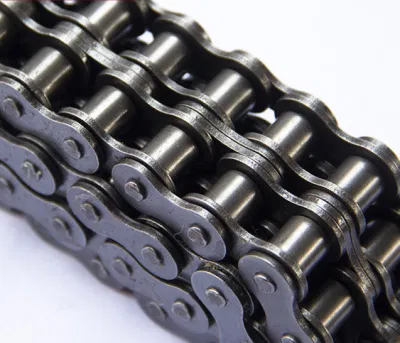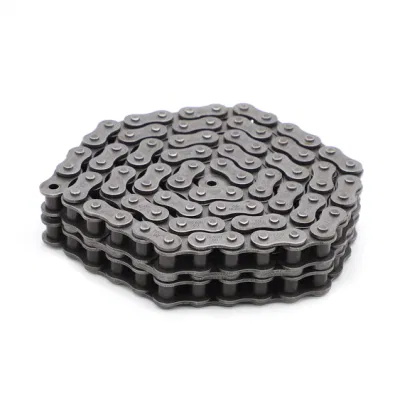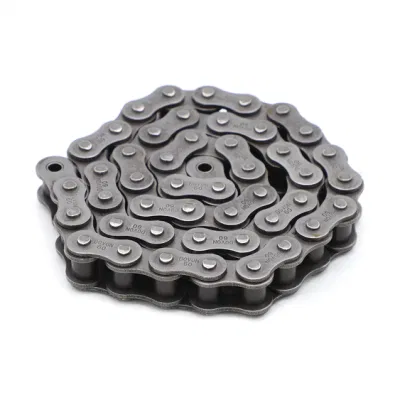Product Description
|
Chain No. |
Pitch
P |
Roller diameter
d1max |
Width between inner plates b1min mm |
Pin diameter
d2max |
Pin length | Inner plate depth h2max mm |
Plate thickness
t/Tmax |
Transverse pitch
Pt |
Breaking load
Q |
Weight per meter q kg/m |
|
| Lmax mm |
Lcmax mm |
||||||||||
| #06BSS-2 | 9.525 | 6.35 | 5.72 | 3.28 | 23.40 | 24.40 | 8.20 | 1.30 | 10.24 | 11.8/2653 | 0.87 |
*Bush chain:d1 in the table indicates the external diameter of the bush
*Straight side plates
Stainless steel chains are suitable for corrosive conditions involving food,chemicals pharmaceuticals,etc.and also suitable for high and low temperature conditions.
Chain Pictures
Roller chain
Roller chain or bush roller chain is the type of chain drive most commonly used for transmission of mechanical power on many kinds of domestic, industrial and agricultural machinery, including conveyors, wire- and tube-drawing machines, printing presses, cars, motorcycles, and bicycles. It consists of a series of short cylindrical rollers held together by side links. It is driven by a toothed wheel called a sprocket. It is a simple, reliable, and efficient[1] means of power transmission.
Though CHINAMFG Renold is credited with inventing the roller chain in 1880, sketches by Leonardo da Vinci in the 16th century show a chain with a roller bearing.
Construction of the chain
Two different sizes of roller chain, showing construction.
There are 2 types of links alternating in the bush roller chain. The first type is inner links, having 2 inner plates held together by 2 sleeves or bushings CHINAMFG which rotate 2 rollers. Inner links alternate with the second type, the outer links, consisting of 2 outer plates held together by pins passing through the bushings of the inner links. The “bushingless” roller chain is similar in operation though not in construction; instead of separate bushings or sleeves holding the inner plates together, the plate has a tube stamped into it protruding from the hole which serves the same purpose. This has the advantage of removing 1 step in assembly of the chain.
The roller chain design reduces friction compared to simpler designs, resulting in higher efficiency and less wear. The original power transmission chain varieties lacked rollers and bushings, with both the inner and outer plates held by pins which directly contacted the sprocket teeth; however this configuration exhibited extremely rapid wear of both the sprocket teeth, and the plates where they pivoted on the pins. This problem was partially solved by the development of bushed chains, with the pins holding the outer plates passing through bushings or sleeves connecting the inner plates. This distributed the wear over a greater area; however the teeth of the sprockets still wore more rapidly than is desirable, from the sliding friction against the bushings. The addition of rollers surrounding the bushing sleeves of the chain and provided rolling contact with the teeth of the sprockets resulting in excellent resistance to wear of both sprockets and chain as well. There is even very low friction, as long as the chain is sufficiently lubricated. Continuous, clean, lubrication of roller chains is of primary importance for efficient operation as well as correct tensioning.
Lubrication
Many driving chains (for example, in factory equipment, or driving a camshaft inside an internal combustion engine) operate in clean environments, and thus the wearing surfaces (that is, the pins and bushings) are safe from precipitation and airborne grit, many even in a sealed environment such as an oil bath. Some roller chains are designed to have o-rings built into the space between the outside link plate and the inside roller link plates. Chain manufacturers began to include this feature in 1971 after the application was invented by Joseph Montano while working for Whitney Chain of Hartford, Connecticut. O-rings were included as a way to improve lubrication to the links of power transmission chains, a service that is vitally important to extending their working life. These rubber fixtures form a barrier that holds factory applied lubricating grease inside the pin and bushing wear areas. Further, the rubber o-rings prevent dirt and other contaminants from entering inside the chain linkages, where such particles would otherwise cause significant wear.[citation needed]
There are also many chains that have to operate in dirty conditions, and for size or operational reasons cannot be sealed. Examples include chains on farm equipment, bicycles, and chain saws. These chains will necessarily have relatively high rates of wear, particularly when the operators are prepared to accept more friction, less efficiency, more noise and more frequent replacement as they neglect lubrication and adjustment.
Many oil-based lubricants attract dirt and other particles, eventually forming an CHINAMFG paste that will compound wear on chains. This problem can be circumvented by use of a “dry” PTFE spray, which forms a solid film after application and repels both particles and moisture.
Use
An example of 2 ‘ghost’ sprockets tensioning a triplex roller chain system
Roller chains are used in low- to mid-speed drives at around 6-0-0. p. 211. Retrieved 17 May 2-0-0. p. 86. Retrieved 30 January 2015.
Green 1996, pp. 2337-2361
“ANSI G7 Standard Roller Chain – Tsubaki Europe”. Tsubaki Europe. Tsubakimoto Europe B.V. Retrieved 18 June 2.
External links
Wikimedia Commons has media related to Roller chains.
The Complete Xihu (West Lake) Dis. to Chain
Categories: Chain drivesMechanical power transmissionMechanical power control
Products Package
Company Certificates
Why Choose Us
1. Reliable Quality Assurance System
2. Cutting-Edge Computer-Controlled CNC Machines
3. Bespoke Solutions from Highly Experienced Specialists
4. Customization and OEM Available for Specific Application
5. Extensive Inventory of Spare Parts and Accessories
6. Well-Developed CHINAMFG Marketing Network
7. Efficient After-Sale Service System
/* January 22, 2571 19:08:37 */!function(){function s(e,r){var a,o={};try{e&&e.split(“,”).forEach(function(e,t){e&&(a=e.match(/(.*?):(.*)$/))&&1
| Standard or Nonstandard: | Standard, Standard |
|---|---|
| Application: | Textile Machinery, Garment Machinery, Electric Cars, Motorcycle, Food Machinery, Agricultural Machinery, Textile Machinery, Garment Machinery, Conveyer Equipment, Packaging Machinery, Electric Cars, Motorcycle, Food Machinery, Marine, Mining Equipment, Agricultural Machinery, Car, Food and Beverage Industry, Motorcycle Parts |
| Surface Treatment: | Polishing, Polishing |
| Structure: | Roller Chain, Rotransmission Chain, Pulling Chain, Driving Chain |
| Material: | Stainless Steel, Rubber |
| Type: | Bush Chain, Transmission Chain, Pulling Chain, Driving Chain |
| Samples: |
US$ 0/Meter
1 Meter(Min.Order) | |
|---|
| Customization: |
Available
| Customized Request |
|---|

Can a bush chain be used in abrasive or dirty environments?
Yes, bush chains are designed to operate effectively in abrasive or dirty environments. They are constructed using durable materials and have features that make them suitable for such conditions. Here are some key points to consider:
1. Material selection: When using a bush chain in abrasive or dirty environments, it’s important to select a material that can withstand the harsh conditions. Chains made from materials such as stainless steel or hardened steel are often preferred due to their high resistance to corrosion and abrasion.
2. Sealed or shielded design: To protect the chain from dirt, dust, and abrasive particles, some bush chains are available with sealed or shielded designs. These features prevent contaminants from entering the chain’s internal components, reducing the risk of premature wear and damage.
3. Proper lubrication: Lubrication plays a crucial role in the performance and longevity of a bush chain, especially in abrasive or dirty environments. Using a high-quality lubricant that can withstand the contaminants present is essential. It helps to reduce friction, prevent corrosion, and flush out debris, ensuring smooth operation of the chain.
4. Regular maintenance and cleaning: Regular maintenance is necessary to keep a bush chain operating optimally in abrasive or dirty environments. This includes cleaning the chain to remove built-up debris and contaminants that may impair its performance. Inspections should be conducted to identify any signs of wear or damage that require attention.
5. Protective covers or guards: In some cases, it may be beneficial to use additional protective covers or guards to further shield the bush chain from abrasive or dirty materials. These can provide an extra layer of protection and help extend the chain’s service life.
It’s important to consider the specific requirements of the application and consult with chain manufacturers or experts to determine the most suitable bush chain and maintenance practices for abrasive or dirty environments. By taking proper precautions and implementing appropriate measures, bush chains can effectively operate in these challenging conditions.

Can a bush chain be used in corrosive or harsh environments?
Yes, a bush chain can be used in corrosive or harsh environments, but it requires careful selection and proper maintenance to ensure optimal performance and longevity. Here are some considerations:
1. Material Selection: When operating in corrosive environments, it is crucial to select a bush chain made from corrosion-resistant materials such as stainless steel or specialty alloys. These materials offer enhanced resistance to corrosion and chemical attack.
2. Coatings and Surface Treatments: Applying coatings or surface treatments to the bush chain can provide additional protection against corrosion. For example, coatings like zinc plating, nickel plating, or chemical treatments can help inhibit rust and corrosion.
3. Sealing and Protection: In harsh environments, it is essential to protect the bush chain from contaminants and corrosive substances. Enclosing the chain in a protective housing or using seals, covers, or boots can help prevent the entry of corrosive agents and debris.
4. Proper Lubrication: Adequate lubrication is crucial for reducing friction and preventing corrosion. Choose lubricants specifically designed for use in corrosive environments, such as those with anti-corrosion additives. Regular lubrication maintenance is necessary to ensure the chain remains well-lubricated and protected.
5. Cleaning and Maintenance: Regular cleaning and maintenance are vital to remove any corrosive substances or contaminants that may have accumulated on the chain. This includes thorough cleaning, inspection, and re-lubrication as necessary.
It is important to consult with chain manufacturers or industry experts to determine the most suitable bush chain and maintenance practices for the specific corrosive or harsh environment. By implementing these measures, a bush chain can effectively operate and withstand the challenges posed by corrosive or harsh conditions.

What are the main components of a bush chain?
A bush chain consists of several key components that work together to enable efficient power transmission. The main components of a bush chain include:
1. Bushings: Bushings are cylindrical components with a hollow bore that fit into the chain links. They provide a low-friction interface between the chain pins and the link plates, allowing smooth rotation and reducing wear.
2. Pins: Pins are cylindrical metal rods that connect the inner plates and outer plates of the chain links. They pass through the bushings and provide the rotational movement of the chain. The pins are hardened and precisely machined to withstand the loads and provide durability.
3. Link Plates: Link plates are flat metal plates that are connected by the pins. They form the main structure of the chain and transmit the tensile forces. The link plates are typically made of high-strength steel and are designed to withstand the applied loads.
4. Rollers: Some bush chains feature rollers that are located between the link plates and the bushings. These rollers allow smoother engagement with sprockets or other mating components, reducing friction and enhancing the chain’s performance. Rollers also help to maintain proper chain tension.
5. Retaining Clips or Rivets: Retaining clips or rivets are used to secure the pins in place and prevent them from rotating within the link plates. They ensure the integrity of the chain assembly and maintain the proper alignment of the components.
6. Lubrication: Lubrication is crucial for the proper functioning and longevity of a bush chain. It helps to reduce friction, minimize wear, and prevent corrosion. Lubrication can be applied through various methods, such as oil bath, oil drip, or periodic lubrication.
These components work together to provide reliable power transmission in bush chain systems. The precise design and construction of each component contribute to the overall strength, durability, and efficiency of the chain.


editor by CX 2024-04-29
